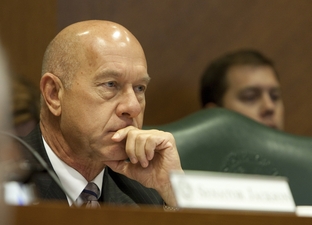Taking a Bite Out of Crime Victim Funds

A parade of crime victims service providers pleaded with the Senate Criminal Justice Committee this week to find a way to keep funding the critical support they offer to those who have been raped, robbed and otherwise traumatized by criminals.
“These are children who are young, who are traumatized and who are floating in strange water,” Vicki Spriggs, CEO of Texas Court Appointed Special Advocates, told lawmakers of the youths her agency works with who have been removed from their parents’ care.
Crime victims organizations statewide are bracing for up to a 50-percent cut in financing from the Texas Compensation to Victims of Crime Fund in 2013. A perfect storm of declining revenue, inaccurate financial forecasting and penny-pinching by lawmakers resulted in a projected $16 million shortfall in the fund. And Texas Attorney General Greg Abbott’s office, which manages the fund, has told groups like the CASA to start scrimping and saving.
At the interim hearing Wednesday, Daniel Hodge, first assistant attorney general, told committee Chairman Sen. John Whitmire, D-Houston, that they need to find a solution not only for the 2013 shortfall, but for fixing the fund’s revenue stream for the long term.
The fund was created in 1979 to help offset the costs associated with victimization, like funeral expenses and medical bills. Lawmakers hoped to ease the rehabilitation process for victims and increase the likelihood that they would be able to help police catch perpetrators.
The law requires the AG’s office to cover 100 percent of the expenses of individual crime victims who qualify for reimbursement. Remaining money can then be used to provide grants to other agencies that provide services to victims. In 2011, the fund budget was estimated at more than $85 million, according to a legislative appropriations request from the AG's office.
For years, those remaining funds — millions of dollars — have gone to services like CASA, rape crisis centers and family violence prevention groups.
But last year as lawmakers were scrounging to fill a multibillion-dollar budget shortfall, they allocated excess money that they expected to be available in the crime fund to pay for other victims’ services that had previously been paid for with general revenue. The problem is that they relied on an overestimation to allocate those funds. That overestimation created the current shortfall.
The long-term funding problem, though, is more systemic, Hodge explained to the committee. The fund relies on the collection of court fees by counties. The amount of fees collected, though, has been falling by about 3 percent per year for several years, he said.
The largest 10 cities and counties in Texas, excluding San Antonio and Corpus Christi, he said reported about $210 million in uncollected court costs.
“We do need to look at what dollars are not being collected that could be,” Hodge said.
In a comment that surely was of little comfort to advocates for the service providers in the audience at the hearing, Whitmire said that although their work is worthwhile, lawmakers should focus on the core purpose of the fund: directing payments to victims.
“What’s kind of frustrating, or sad, is that there are so many good competing interests,” Whitmire said, adding that the state isn’t likely to have any more money during the next legislative session than they had in the last. In the interim, he said, they’ll be looking for solutions to keep funding the increased need for services with a dwindling state budget.

